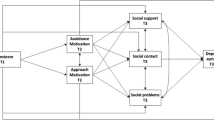Abstract
A recent investigation by Rosenberg and Rosenberg used longitudinal data from the Youth in Transition study to explore the causal relationships between delinquency and self-esteem. The present study is based on the same sample of young men in high school and extends Rosenberg and Rosenberg's analysis, first by using the same cross-lagged correlation methods applied over a longer time period, and then by employing a “causal modeling” approach using the LISREL computer program. Each of the analyses was carried out using the total sample as well as two subsamples, the highest and lowest quartiles in initial self-esteem. The causal modeling analyses attempted (a) to take careful account of the actual periods referenced by the measures of delinquency and self-esteem, (b) to control socioeconomic status and ability, and (c) to extend the model to demonstrate ways in which participation in teenage social life and current educational attainment might also influence and be influenced by self-esteem. The analyses suggest that self-esteem plays little part in influencing the teenage behaviors and orientations that follow in time. Consistent with Kaplan's prediction, among young men who enter high school with low self-esteem, the effects of delinquent behavior tend primarily to be self-enhancing.
Similar content being viewed by others
References
Ammons, R. B., and Ammons, C. H. (1962). The Quick Test (QT): Provisional manual.Psychol. Rep. 11: 111–161. (Monogr. Suppl. I–VII.)
Andrews, F. M., and Crandall, R. (1976). The validity of self-reported measures of well-being.Soc. Indicat. Res. 3: 1–14.
Bachman, J. G. (1970).Youth in Transition, Volume II: The Impact of Family Background and Intelligence on Tenth-Grade Boys, Institute for Social Research, Ann Arbor, Mich.
Bachman, J. G., and O'Malley, P. M. (1977). Self-esteem in young men: A longitudinal analysis of the impact of educational and occupational attainment.J. Personal. Soc. Psychol. 35: 365–380.
Bachman, J. G., O'Malley, P. M., and Johnston, J. (1978).Youth in Transition, Volume VI: Adolescence to Adulthood—Change and Stability in the Lives of Young Men, Institute for Social Research, Ann Arbor, Mich.
Bynner, J. M. (1969).The Young Smoker, Her Majesty's Stationery Office, London.
Bynner, J. M. (1979). Adolescent culture and delinquent values. Mimeographed.
Cloward, R. A., and Ohlin, L. E. (1960).Delinquency and Opportunity, Free Press, New York.
Cobb, S., Brooks, G. H., Kasl, S. V., and Connelly, W. E. (1966). The health of people changing jobs: A description of a longitudinal study.Am. J. Publ. Hlth. 56: 1476–1481.
Cohen, A. K. (1955).Delinquent Boys, Free Press, New York.
Coopersmith, S. (1967).The Antecedents of Self-Esteem, Freeman, San Francisco.
Downes, D. M. (1966).The Delinquent Solution: A Study in Subcultural Theory, Collier Macmillan, London.
Duncan, O. D. (1961). A socioeconomic index for all occupations, and properties and characteristics of the socioeconomic index. In Reiss, A. J. (ed.),Occupations and Social Status, Free Press, New York.
Elliott, D. S., and Voss, H. L. (1974).Delinquency and Drop-Out, Heath, Lexington, Mass.
Gates, A. I. (1958).Gates Reading Survey—From I, Teachers College, Columbia University, New York.
Gold, M. (1978). Self-esteem and delinquent behavior: A theory of alternative schools.Crime Delinquent. Literat. July, 290–308.
Gold, M., and Mann, D. (1972). Delinquency as defense.Am. J. Orthopsychiat. 42: 463–469.
Gold, M., and Reimer, D. J. (1975). Changing patterns of delinquency.Crime Delinquen. Literat. December: 483–513.
Joreskog, K. G., and Sorbom, D. (1978).LISREL IV: Analysis of Linear Structural Relationships by the Method of Maximum Likelihood, Users' Guide, National Educational Resources, Chicago.
Joreskog, K. G., and Sorbom, D. (1979).Advances in Factor Analysis and Structural Equation Models, Abt. Associates, Cambridge, Mass.
Kaplan, H. B. (1975).Self Attitudes and Deviant Behavior, Goodyear, Pacific Palisades, Calif.
Kaplan, H. B. (1977). Increase in self-rejection and continuing/discontinued deviat response.J. Youth Adoles. 6: 77–87.
Kaplan, H. B. (1978). Deviant behavior and self-enhancement in adolescence.J. Youth Adoles. 7: 253–277.
Matza, D. (1964).Delinquency and Drift, Wiley, New York.
McCord, J. (1978). Comments on “Self-esteem and delinquency.”J. Youth Adoles. 7: 291–293.
Mead, G. H. (1934).Mind, Self and Society, University of Chicago Press, Chicago.
O'Malley, P. M., and Bachman, J. G. (1979). Self-esteem and education: Sex and cohort comparisons among high school seniors.J. Personal. Soc. Psychol. 37: 1153–1159.
Pelz, D. C., and Andrews, R. M. (1964). Detecting causal priorities in panel data.Am. Sociol. Rev. 29: 836–848.
Rosenberg, F. R., and Rosenberg, M. (1978a). Self-esteem and delinquency.Journal of Youth and Adolescence 7: 279–291.
Rosenberg, F. R., and Rosenberg, M. (1979b). Reply to Joan McCord's comment.J. Youth Adoles. 7: 293–294.
Rosenberg, M. (1965).Society and the Adolescent Self-Image, Princeton University Press, Princeton, N.J.
Wheaton, B., Muthen, B., Alwin, D. E., and Summers, G. F. (1977). Assessing reliability and stability in panel models. In Heise, D. R. (ed.),Sociological Methodology, 1977, Jossey-Bass, San Francisco.
Author information
Authors and Affiliations
Additional information
This research was supported by an Open University Research Grant awarded to John Bynner while a Fulbright-Hays Scholar at the Institute for Social Research, University of Michigan.
Completed his first degree in Psychology at the University of Bristol and his doctorate at the University of London. Main research interests are adolescent values and research methodology.
Received his Ph.D. from the University of Michigan. Main research interests are youth and social issues and developmental psychology.
Received his Ph.D. from the University of Pennsylvania. Main research interest are studies of youth and social issues.
Rights and permissions
About this article
Cite this article
Bynner, J.M., O'Malley, P.M. & Bachman, J.G. Self-esteem and delinquency revisited. J Youth Adolescence 10, 407–441 (1981). https://doi.org/10.1007/BF02087937
Received:
Issue Date:
DOI: https://doi.org/10.1007/BF02087937




